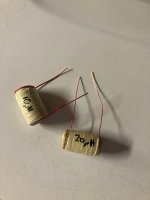Hi,
I have a XO design (OSMC) that calls for specific coils. Looking at the prices of suppliers, I'm wondering if I could wind my own? What would be the choice of "I" laminate, bobbins. Are there suppliers that would supply the laminate and bobbins? UK/EU
I have an inductance meter and am in the process of building a milliohm meter -
https://worldradiohistory.com/UK/Practical-Television/00s/Television-2005-07.pdf (page 534)
Many thanks.
Earl
I have a XO design (OSMC) that calls for specific coils. Looking at the prices of suppliers, I'm wondering if I could wind my own? What would be the choice of "I" laminate, bobbins. Are there suppliers that would supply the laminate and bobbins? UK/EU
I have an inductance meter and am in the process of building a milliohm meter -
Many thanks.
Earl
Are there suppliers that would supply the laminate and bobbins? UK/EU
https://www.qtasystems.co.uk/loudspeaker-components/inductors.htm
If you value your time, I'd say just spend the $$. Winding coils is a PITA.
Air core coils can be wound over a wooden dowel. Simplicity itself.
This is DIY, remember. We do this stuff in order to just do it.
😎
😎
Is there some way to calculate or estimate how big a bobbin would be required given a target inductance, a certain laminate core, and wire diameter?
There was a website that could calculate that for air cores. I can't recall the name...
If you look at Solen's website, they have a pdf doc that dims all of their air cores in their optimal geometry.
I never look at it though, as I wind until value is reached that I need.
If you look at Solen's website, they have a pdf doc that dims all of their air cores in their optimal geometry.
I never look at it though, as I wind until value is reached that I need.
This was the calculator I used when I designed a time-aligned, linear phase speaker some years ago. It was accurate within a couple turns on an inductor with hundreds of turns.
The thing about designing and setting up a speaker is, the real world values needed in a crossover tend to be slightly different than calculated. This is where winding your own really comes in handy. I tapped mine at several values in case I needed a little higher or lower inductance for notch filters.
https://www.diyaudioandvideo.com/Calculator/AirCoreInductorDesigner/
The thing about designing and setting up a speaker is, the real world values needed in a crossover tend to be slightly different than calculated. This is where winding your own really comes in handy. I tapped mine at several values in case I needed a little higher or lower inductance for notch filters.
https://www.diyaudioandvideo.com/Calculator/AirCoreInductorDesigner/
Last edited:
Here's a worked example. I needed a pair of 0.05mH coils for a crossover I was designing, so I used an online calculator to estimate that I needed 32 turns of 1mm wire over a 24mm diameter air core. I had scraps of 16 AWG and 20 AWG magnet wire laying around, and some corks, so I gave it a go. This is what I got, with inductances measured using a cheap LC meter, which I believe systematically underestimates the inductance, but idk by how much. I ended up buying a pair of 0.05mH coils from Madisound for $2.30 apiece plus shipping.
Attachments
If you mean some Chinese clone of the AVR transistortester then I have the same and using Solen air core inductors as guide it seems pretty consistently underestimating inductance by roughly one E24 step which is around 6%. Thanks for confirming that it is not just me, if that's also what you are using to measure the inductance. Inductors I ordered straight from China rated +/-5% would measure around 6-11% less. Solen did not seem to specify the tolerance. I don't know if I should blame it on the cheap meter or on copper being expensive.
Thank you very much for the very helpful replies!!! So I guess iron cores are not as straightforward to calculate, then.
Thank you very much for the very helpful replies!!! So I guess iron cores are not as straightforward to calculate, then.
it looks peaceful to wind your own parts, like caps
https://stereo-magazine.com/fileadmin/user_upload/WilsonCap_web.jpg
https://stereo-magazine.com/fileadmin/user_upload/WilsonCap_web.jpg
Cyberstudio, this is a good program and very user friendly.
https://www.diyaudioandvideo.com/Calculator/AirCoreInductorDesigner/
https://www.diyaudioandvideo.com/Calculator/AirCoreInductorDesigner/
The easiest way to wind an air-core coil is:
- Wind an approximate number of turns and measure the inductance. http://info.ee.surrey.ac.uk/Workshop/advice/coils/air_coils.html
- Add/remove turns to fine-tune the value according to : L1 / L2 = (N1 / N2)^2, where Nx represents the number of turns for inductance Lx.
Last edited:
I found a nice slow rotation on my little lathe did the trick.
https://www.instagram.com/p/COYB6tignm6/?igshid=MTc4MmM1YmI2Ng==
https://www.instagram.com/p/COYB6tignm6/?igshid=MTc4MmM1YmI2Ng==
- Home
- Loudspeakers
- Multi-Way
- DIY coils for Crossover
